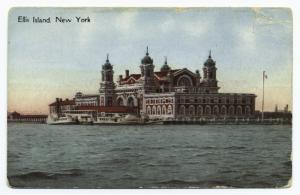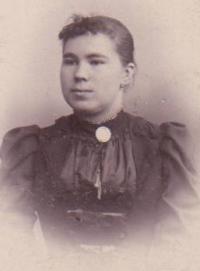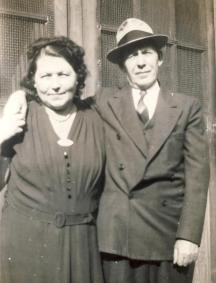This 3-part series of posts uses my cousin’s interview in 1985 with the Ellis Island Oral History Project. Part 1 tells the story of Ludwig and Mary Schultz, who came to America in 1912 and temporarily left their five children with Mary’s parents. In Part 2, their daughter, Louise, discusses living with her grandparents and the eventual journey across the ocean to join their parents. In today’s post, Part 3 will tell more about what happened after their arrival, how the family left behind fared in Poland after they left, and how everyone’s life eventually turned out.
The Family Left Behind
Before discussing the Schultz family’s life in America, one interesting question asked by the interviewer in 1985 was: “Do you have any idea of what would have happened to you if you stayed in Poland, if you hadn’t come here?”
Louise responded: “Pretty awful, because we came in 1913 and in 1914 the first World War broke out.” What happened to the grandparents, uncles, and aunts they left behind?
The children’s grandfather and Alfred’s father, Jan Miller, died just three weeks after they left Poland. He passed away on 25 August 1913, leaving Elżbieta a widow with three children still at home: Paweł, Ludwik, and Zofie.
When the war began, Żyrardów was on the front line. Hundreds of workers were drafted into the army. Because of the decrease in workers and the lack of raw materials, the factory began to reduce production. Food prices increased. As German troops made their way through Russian Poland, martial law was declared.
In early 1915, goods, raw materials, and machines were removed from the factory. The town was deserted due to forced digging of trenches, general displacement, and epidemics of infectious diseases. The worst came after the collapse of the front line of Płock-Bzura-Rawka. On the night of July 16, 1915, the retreating Russian army blew up the main factory buildings. By the end of 1915, the town was under German occupation. During that time, charity committees were abolished and strict food regulation was imposed.
In an article in The New York Times on October 26, 1915 (originally printed in The Chicago Tribune on September 24), reporter James O’Donnell Bennett writes about crossing “Russian Poland” which at that time in the war was in German or Austrian control. He writes:
Often in the last five days I have made the experiment of looking out over the wide landscape to see if I could find an unscathed tract of country. Always the experiment is a failure. Always a shattered church tower notches itself against the sky or a battered village lies crumpled at the edge of fields.
The reporter mentions several towns his party traveled through, including Żyrardów. He describes the whole country as “flyblown and sodden and a ‘nobody cares’ atmosphere envelops it…It is all waste and wreckage, wreckage and waste, a land of grime and ruin and sour smells, of silent fields and slatternly women, of weary sentries…”
Louise said her aunt eventually told her what it was like during the war and “how awful it was when the German army went through the town.” Louise realized that she and her siblings “just missed the horror of a war. They used to hide in cellars and had no food. My grandmother went from one farm to another to beg for a piece of bread.”

Ludwik Miller
I am not certain exactly what happened to Paweł Miller. According to Louise, her aunt Zofie said he was part of the Soviet roundups in Żyrardów that sent residents to Siberia. He did not return from the exile and presumably died there. Their sister, Karolina Miller Razer, may have suffered the same fate; Zofie said she died “in prison”.
Ludwik Miller, a young teenager, either joined or was conscripted into the Russian Army sometime during the Great War. He survived the experience and lived a long life. Ludwik did not immigrate to America. He married twice and had no children, and owned a footwear store in Żyrardów. He died there sometime after 1977.

Elizabeth Smetana Miller with great-granddaughter, Lucille (Louise’s daughter). Long Island, NY, 1925.
The oldest brother, Emil Miller, who was the first of the family to immigrate to America, actually returned to Poland in 1913 after the death of his father. He brought his wife and their children, two of whom were born in America, but after the war began there was no way to leave. Emil and one of his daughters died in Poland during the war. Emil’s wife, Zofja, and American-born son Edward could finally return to America in 1927 (Edward) and 1929 (Zofja). Another daughter stayed behind in Żyrardów.
Widowed Elżbieta and her youngest child, Zofie, would eventually immigrate to America themselves. They sailed aboard the Megantic from Liverpool and arrived in Portland, Maine on 10 December 1920. Elżbieta, or Elizabeth as she was called in America, lived for a time with Alfred in New York, then with Mary in New Jersey. She died on 08 November 1944.
The Schultz Family in America
Finally in America after a long, scary journey, Louise said, “My first impression was pretty awful! Because [in Poland] we lived surrounded by trees and orchards and little houses by themselves.” In America, they lived in downtown Manhattan “on 16th Street, that’s where we moved first. The place looked dirty to me, crowded dirty.” But the family adjusted. Louise was particularly good at learning the new language and communicating on behalf of her parents who, according to her, did not make as much of an effort in assimilating.

The Schultz Family in America, circa 1923. Top row from left: Louise, Mary, Ludwig, Edward. Bottom row from left: Walter, Julia, Henry.
The Schultz family enjoyed their new lives in America. They lived in Brooklyn, then in New Jersey’s Somerset county. Eventually they moved to Metuchen in Middlesex county, New Jersey. Ludwig died in 1950 at the age of 77, and Mary in 1969 at the age of 85.
Henry, who never married, was the first of the Schultz children to die in 1954 at only 46 years old. Edward married and had three children; he died in 1984 at the age of 75. Walter, a decorated U.S. Army Air Corps veteran, died in 1986 at the age of 78. Louise, the source of this wonderful story, married twice and had two daughters; she died in 1990 at the age of 87. The youngest, Julia, married and moved to California where she had two children; she died in 2003 at the age of 93.
I should also note what happened to Alfred Miller, the brave teenaged uncle who brought his nieces and nephews to America! Alfred lived with the Schultz family for some time. In 1921, he got married. The couple had a daughter in 1922 and a son in 1926. Alfred died in 1969, two months after his sister Mary, in Piscataway, NJ.
The only Miller sibling that I did not provide an update on was Elizabeth, my great-grandmother. See her story and a photograph of her with her brother Alfred, sister Mary, and some of the Schultz children here.

Louise Schultz Nagy
When Louise was 82 years old, she was interviewed about the journey she took as a young girl for the Ellis Island Oral History Project. Thanks to that transcript, I was able to learn not only about traveling by ship to America, but also a little about her family, what life was like in Poland before and after she left, and her impressions about life in America. Thank you, cousin Louise, for sharing your journey with all of us!















 A recurring theme on this site is my desire to find photographs of my ancestors because I have so few. I even entitled one post about Elizabeth “
A recurring theme on this site is my desire to find photographs of my ancestors because I have so few. I even entitled one post about Elizabeth “
 I finally took my own journey to Ellis Island in the summer of 2010 with five genealogist friends. It was a wonderful experience. I was surprised the “Great Hall” was not quite as large as it looks in photographs. What made our trip meaningful was that all of us had ancestors who arrived through that port and the realization that their fateful decision to come here shaped our own lives.
I finally took my own journey to Ellis Island in the summer of 2010 with five genealogist friends. It was a wonderful experience. I was surprised the “Great Hall” was not quite as large as it looks in photographs. What made our trip meaningful was that all of us had ancestors who arrived through that port and the realization that their fateful decision to come here shaped our own lives.







 This week I am highlighting some random facts about passenger lists. Today’s post won’t offer any helpful searching hints or useful sites. Instead, let’s journey down memory lane to the good old days before we did our research on the internet. Wait, why exactly do we call them the good old days?
This week I am highlighting some random facts about passenger lists. Today’s post won’t offer any helpful searching hints or useful sites. Instead, let’s journey down memory lane to the good old days before we did our research on the internet. Wait, why exactly do we call them the good old days?









 I noticed that the manifest had a big “X” next to her line number. That is a signal that the passenger was detained for some reason, and there may be more information available. For more information, see
I noticed that the manifest had a big “X” next to her line number. That is a signal that the passenger was detained for some reason, and there may be more information available. For more information, see 




